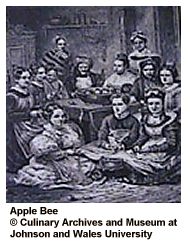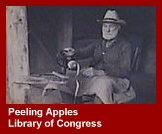 |
|||
Apple pie and Mom: what could be more American? The problem is: apple pie was a British invention and English colonists brought apples to America. The unique American aspect of apples, are the varieties developed here: Golden and Red Delicious, Jonathan, and McIntosh. More than 2,500 varieties of apples grow in America today, and 4,300,000 tons are produced annually. From "an apple a day," to icon of the computer industry.... American apples have unique stories
|
JOHNNY APPLESEED
FOURTH OF JULY ON THE BANKS OF THE PLATTE RIVER The banquet hall was formed of four wagons - two on each side covered over with tent cloths. There were tin platters and iron spoons, and knives and forks for the ladies. Down the center, the luxuries of the season were placed in tin pans: boiled beans and salt pork, bean broth, middling bacon, ship bread, and hot rolls of wheat bread, dried apple and peach pies, and stewed dried apples. The Star-spangled banner, floated through an opening in the roof. J. Goldsborough Bruff, 1849 [4: 5]
A PASSENGER' RECOLLECTION: I came to a corn-field... Grain by grain I worked away... when my jaws grew tired, I would rest, and then begin afresh... I felt that my life was at least safe from death by hunger. James Pennington, 1850 [4: 6]
RECIPE FOR NEW ENGLAND PIE - WITH A HUMOROUS TWIST To make this excellent breakfast dish, proceed as follows: Take a sufficiency of water and a sufficiency of flour, and construct a bullet-proof dough. Work this into the form of a disk, with the edges turned up some three-fourths of an inch. Toughen and kiln-dry it a couple of days in a mild but unvarying temperature. Construct a cover for this redoubt in the same way and of the same material. Fill with stewed dried apples; aggravate with cloves, lemon-peel, and slabs of citron; add two portions of New Orleans sugar, then solder on the lid and set in a safe place till it petrifies. Serve cold at breakfast and invite your enemy. Mark Twain |
||
| Timeline: 1848 Gold discovered in California 1849 Gold-seekers flock to California 1852 Self-rising flour invented 1853 Potato chips invented 1853 Transcontinental railroad survey 1854 First Texas to New York cattle drive 1856 Commercial baking powder 1858 Steam-driven field tractor 1860 Milk sterilization (Louis Pasteur) 1861 Start of American Civil War |
|||
| Exhibit Home | Further Resources | Library Home |




